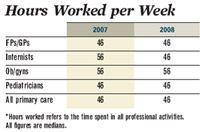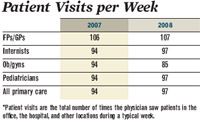Article
2009 productivity survey: How do you compare?
Author(s):
While primary care physicians, by and large, worked as much in 2008 as they did the previous year, the number of patients seen increased just marginally, according to Medical Economics' annual productivity survey.

POSTPONING NEEDED CARE
Primary care doctors saw the same number of patients or fewer in 2008 vs. 2007 because many patients, feeling the economic squeeze of "the great recession" of 2008, cut back on all expenditures, including doctor visits, says Owen Dahl, a practice management consultant in the Woodlands, Texas.

That was the experience of Judy Lindsey, MD, an internist in Milwaukie, Oregon, just outside of Portland. In 2008, Lindsey and her two nurse practitioners saw fewer patients than they saw in 2007, despite working 60 hours a week. "By mid-year, even people who still had jobs could not afford copays or gas to drive to their visits," she says. "Copays and deductibles keep going up, shutting people out of the primary care system until they are so ill they end up in the emergency room."
Kathryn Moghadas, a consultant with Associated Healthcare Advisors in Fern Park, Florida, has seen the same scenario play out with her clients. "When I query my doctors, I am hearing that many patients who have steep copays or high deductibles are using medical care only as a last resort," she says.
This is especially the case with ob/gyns, says Jeffrey Denning, a consultant with Practice Performance Group in La Jolla, California. As the survey indicates, most primary care physicians continue to see approximately the same number of patients per week, but ob/gyns suffered a 10 percent decline in patient visits despite putting in the longest workweeks.

Moreover, ob/gyns have unpredictable hours, with deliveries and complications for which they are not adequately reimbursed, according to Moghadas. And they often must spend more time with individual patients. "Ob/gyns who do not offer other services such as midwifery or medi-spas are feeling the crunch," she says.





